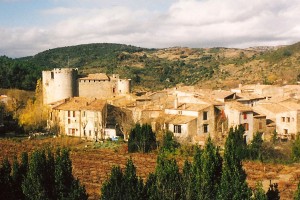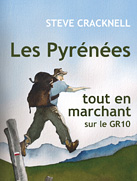
The “Cathar” castle at Peyrepertuse
Thirty years ago this religious sect simply didn’t exist. But now Cathars are everywhere. Much more effective than Jehovah’s Witnesses or Scientologists, they can be found in the local supermarket, in motorway service stations, and even on Mediterranean beaches.
Although the Cathars were a significant force in the 13th century, they had long been relegated to the dustbin of history. Thirty years ago, to all intents and purposes, they didn’t exist. Yet this summer will resonate across 800 years with the echo of the drums which announced the Cathars’ destruction. This summer will tinkle to the sound of Cathar merchandising, as the cash registers take their tithe. The Cathars have been resurrected, modernised, trivialised and, above all, made profitable. A religion which rejected materialism has become a tool of that most modern, most powerful, of religions: consumerism.
The Cathar phoenix
How did it happen? It started with a book. The Inquisition, which had doused the last faintly glowing embers of the Cathar fire at the beginning of the 14th century, was indirectly responsible for bringing the Cathars back to life. The transcripts of the trials were examined by Emmanuel le Roy Ladurie, and published in 1975 as Montaillou, an Occitan village from 1294 to 1324. A remarkable book, it excavates and reassembles the lives of 14th-century peasants, using the verbatim records to study topics which are rarely accessible to historians. Like sex:
[Guillaume Belibaste, as a Cathar leader had renounced pleasure but, as one of the Inquisition witnesses reported]:
“I found them in bed, Guillaume bending his knees as if he were just about to know Raymonde carnally, or as if he had just finished. When Guillaume, caught in the act, noticed me he shouted at me ‘You bastard, you have just disturbed the work of the Holy Church’” (p. 148)
On food:
“I don’t like fish. In any case it wasn’t the season for fish… So I sent one of Guillemette’s sons to buy a goat’s liver” (p. 180)
On religion:
“Do you know how God was created?” I asked Raymond.
“God was made fucking and shitting” was the reply. (p. 208)
On love:
“Because I adored Raymonde, my wife, I loved everything connected with my mother-in-law’s household. For nothing in the world would I have have done something to displease her.” (p. 221)
While most history deals with the powerful, here was a book which gave voice and emotion to the words of the poor.
 Cathars were dissident Catholics who interpreted the Bible in a non-standard way. God’s domain was the Spirit. For Cathars, the material world was corrupt, the realm of Satan. In addition, Churches were not the only place where Christian teaching could take place. For the increasingly rich, increasingly uncatholic Catholic church, the Cathars were dangerous.
Cathars were dissident Catholics who interpreted the Bible in a non-standard way. God’s domain was the Spirit. For Cathars, the material world was corrupt, the realm of Satan. In addition, Churches were not the only place where Christian teaching could take place. For the increasingly rich, increasingly uncatholic Catholic church, the Cathars were dangerous.
But the Cathar’s real problem was that they lived on the periphery of France. The lands were held by local counts who were a little too independent in the eyes of the king, Philippe Auguste. So, with the blessing of the Pope, he sent the ambitious Simon de Montfort to take charge of the troops.
Kill them all
One of the earliest battles became a symbol. On 22 July 1209, the town of Beziers was attacked and a significant part of its population killed, Catholics and Cathars alike. When asked how to distinguish true Catholics from Cathars the papal legate allegedly replied “Kill them all, God will recognise his own.” The words are probably apocryphal, but the sense is clear: there was no room for subtlety. When the armies withdrew from the area after 20 years of slaughter, the persecution continued in the form of the Inquisition, hence le Roy Ladurie’s book.
But the book and the popularisations which followed it wouldn’t on their own have created the Cathar phenomenon we are witnessing this year. There is another voice to the story.
Of cement and stone
On the coast, in the mid-1970s, the cement mixers had begun to churn. Tourism was seen as a replacement for the declining wine industry. But the effects were devastating: the town of Canet-plage in the nearby Pyrénées-Orientales is a concrete wall, bustling in July and August but empty for 10 months of the year. For the hinterland, for the foothills of the Pyrenees known as the Corbières, a different project was needed. Small-scale, green.

Villerouge-Termenès in the high Corbières: Guillaume Belibaste was burned at the stake here in 1321
The second phoenix rose from the ashes of Guillaume Belibaste, who was burned at the stake in Villerouge-Termenès in 1321. At the beginning of the 1980s, this village in the heart of the Corbières had a fine medieval castle but few visitors. So conseiller général (local councillor) Eric Andrieu and friends conceived the idea of a “Cathar Country” to bring together the disparate efforts of the tourism sector.
Here was an idea which was anything but concrete. In the first place there were no Cathar remains to be put on display. There were no castles, no churches, no artifacts, not even a Cathar culture, nothing. After all, the Cathars scorned the material world. The strongholds which had been used by those fleeing persecution had been razed. And although there were several magnificent castles in the Corbières – Quéribus, Peyrepertuse, Villerouge-Termenès, Termes – the visible remains were much later than the Cathar period. Never mind, said the working party, let’s call them the “Castles of the Cathar country”. This was a master stroke. The ruins soon became known as “Cathar castles”, in defiance of all historical accuracy. The main problem being resolved by a turn of phrase, the project could start to apply for European Leader funding.
And despite its rickety historical and cultural foundations, the idea worked. The Cathar Country now involves more than 900 professionals in thirty different sectors. In the village of Cucugan, visitor numbers increased from 7,000 in 1980 to 88,000 in 2000. Which is why you can now see Cathar products – or more accurately “Cathar standard” products, bread, honey, meat, cheese – on roadside stalls and in supermarkets. There are even “Cathar standard” campsites, B&B guest houses and restaurants But enough is enough. As George Freche, the regional president said: “Cathar beaches is going too far. The Cathars never went sunbathing.”
Don’t get me wrong. I think that the Cathar country is a fabulous idea and an original way of stimulating local development. But let’s not confuse marketing with history.
More on Cathar Country marketing









Footprints on the mountains